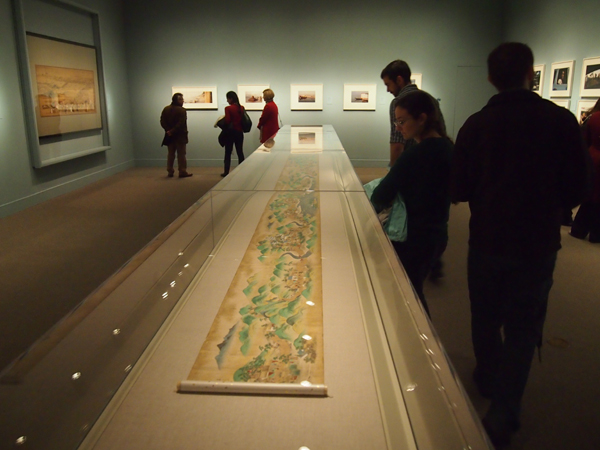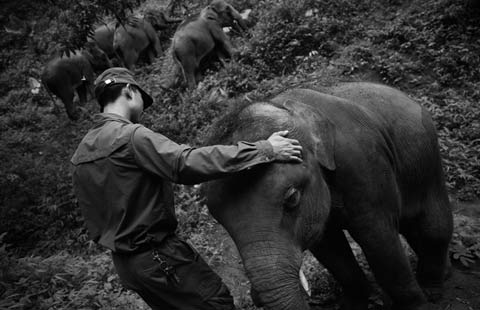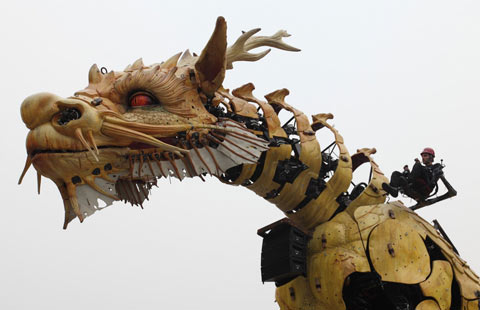Understanding China through art
Updated: 2014-11-27 10:21
By HUA SHENGDUN in Washington(chinadaily.com.cn)
|
|||||||||||
 |
|
Visitors watched an ancient Chinese painting on the exhibition The Traveler's Eye: Scene of Asia, which opened last Saturday through May 2015, at the Arthur M. Sackler Gallery in Washington DC on Wednesday. Yang Sheng / For China Daily |
Because it is a universal language, art has long been a good way for different cultures to connect.
"Art has historically been an important way for communicating ideas about landscape, home and country, as well as foreign lands and journeys," said Debra Diamond, curator of South and Southeast Asian art at the Freer Gallery in Washington and coordinating curator of The Traveler's Eye: Scenes of Asia exhibit, which opened Saturday and runs through May 31, 2015.
"We created the exhibition because artworks have powerfully shaped notions at home and abroad over the centuries," Diamond told China Daily, adding that mutual understanding can be reached through art and culture.
The exhibition juxtaposes East Asian scrolls, Japanese woodblock prints and contemporary photography with maps, archaeological drawings and souvenirs.
Featured are more than 100 works created over the past five centuries, as well as an entire gallery devoted to Chinese landscape paintings from the Chinese Ming and Qing dynasties more than 600 years ago.
The five ancient Chinese paintings on hanging scrolls, hand scrolls and an album leaf, include Travelers in the Springtime Mountains by Qiu Ying, Breaking Waves and Autumn Winds by Dai Jin and some anonymous works portraying commercial travel on land and water.
Through scale, line, and subject, these artworks capture the sights and scenes that a traveler might encounter on a journey. "Travel has been one of the most important themes in Chinese landscape painting," said Allee, who was among the first eight American graduate students allowed to study in China, attending the University of Nanjing from 1979 to 1980.
Photographs recording the visit of Charles Lang Freer, founder of the Freer Gallery, to the Longmen Caves in 1910 were also on display.
There are three photographs of Longmen by Yutai, a photographer who traveled with Freer, as well as a group of ordinary river rocks that Freer collected at the site, and Freer's journals of his visit to Longmen, one of the three notable grottoes in China along with the Yungang Caves in Shanxi and the Mogao Caves in Gansu, Diamond said.
"Freer did not collect any antiquities from Longmen, instead he wrote about them with great sensitivity," said Diamond. "For example, he wrote, in 1910, ‘The day, my first complete one at Lung-men, has been very full and deeply impressive. It has given me an introduction to an amalgamation of sculpture and painting…[that is] perfect in harmonious beauty. Possibly as interesting as any in existence!'"
"Ancient cultures in Asia, especially in China, have much longer histories than North America and Europe," said Saul Birendaum, an independent research professional from Edmonton, Alberta, Canada, who visited the exhibit.
"The exhibition is the very place for me to deeply understand the different cultures in China," he said.
Sheng Yang in Washington contributed to this story
Today's Top News
Nation mulls end of death penalty for some crimes
Men spending more on facial care
Graft fight dents overseas spending
Interracial relationships from the past
Sanctions, falling oil price cost Russia $140b yearly
Ukraine to hold referendum on joining NATO
UN calls for more sex ed in country
PBOC surprise powers equities
Hot Topics
Lunar probe , China growth forecasts, Emission rules get tougher, China seen through 'colored lens', International board,
Editor's Picks

|

|

|

|

|

|





